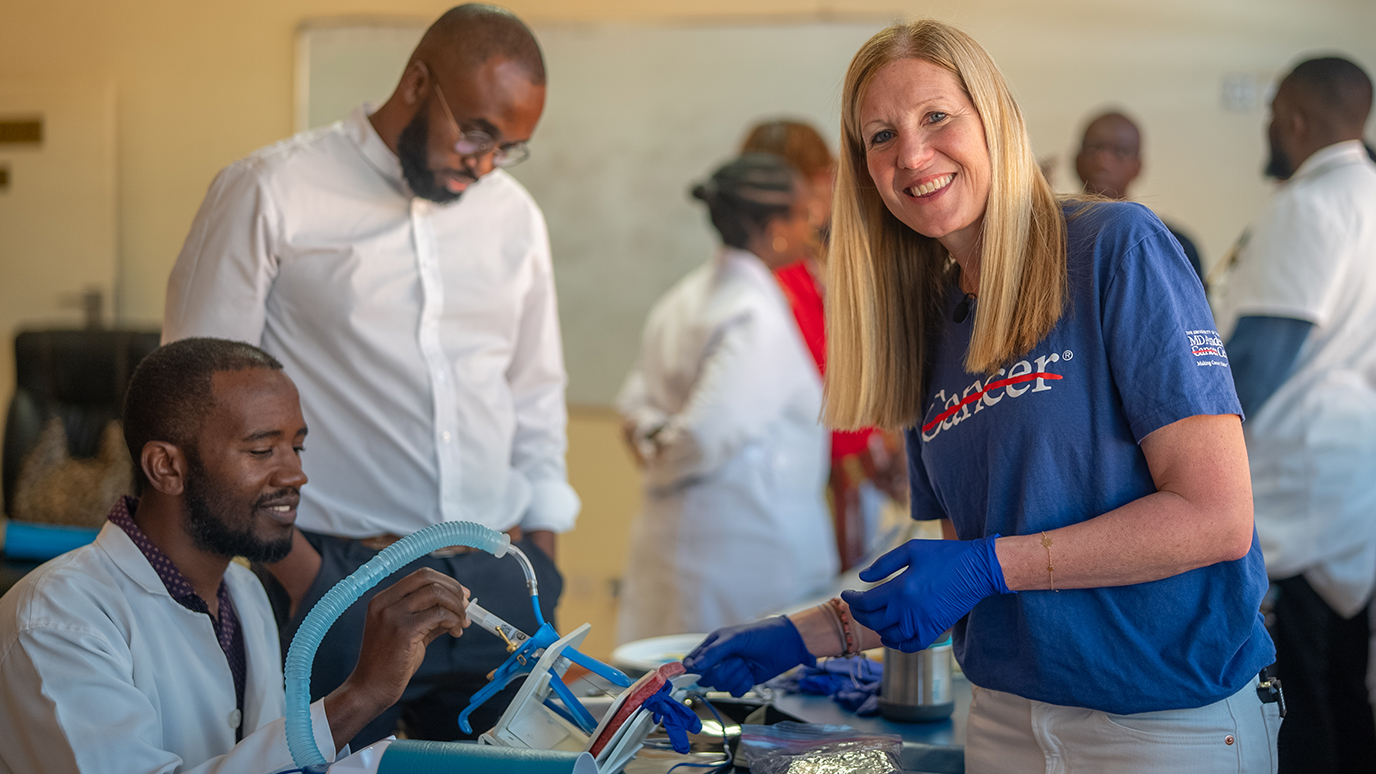- Diseases
- Acoustic Neuroma (14)
- Adrenal Gland Tumor (24)
- Anal Cancer (68)
- Anemia (2)
- Appendix Cancer (16)
- Bile Duct Cancer (26)
- Bladder Cancer (72)
- Brain Metastases (28)
- Brain Tumor (232)
- Breast Cancer (714)
- Breast Implant-Associated Anaplastic Large Cell Lymphoma (2)
- Cancer of Unknown Primary (4)
- Carcinoid Tumor (8)
- Cervical Cancer (158)
- Colon Cancer (166)
- Colorectal Cancer (118)
- Endocrine Tumor (4)
- Esophageal Cancer (44)
- Eye Cancer (36)
- Fallopian Tube Cancer (8)
- Germ Cell Tumor (4)
- Gestational Trophoblastic Disease (2)
- Head and Neck Cancer (12)
- Kidney Cancer (128)
- Leukemia (342)
- Liver Cancer (50)
- Lung Cancer (286)
- Lymphoma (278)
- Mesothelioma (14)
- Metastasis (30)
- Multiple Myeloma (100)
- Myelodysplastic Syndrome (60)
- Myeloproliferative Neoplasm (6)
- Neuroendocrine Tumors (16)
- Oral Cancer (100)
- Ovarian Cancer (172)
- Pancreatic Cancer (160)
- Parathyroid Disease (2)
- Penile Cancer (14)
- Pituitary Tumor (6)
- Prostate Cancer (146)
- Rectal Cancer (58)
- Renal Medullary Carcinoma (6)
- Salivary Gland Cancer (14)
- Sarcoma (238)
- Skin Cancer (296)
- Skull Base Tumors (56)
- Spinal Tumor (12)
- Stomach Cancer (64)
- Testicular Cancer (28)
- Throat Cancer (92)
- Thymoma (6)
- Thyroid Cancer (98)
- Tonsil Cancer (30)
- Uterine Cancer (80)
- Vaginal Cancer (16)
- Vulvar Cancer (20)
- Cancer Topic
- Adolescent and Young Adult Cancer Issues (20)
- Advance Care Planning (10)
- Biostatistics (2)
- Blood Donation (18)
- Bone Health (8)
- COVID-19 (362)
- Cancer Recurrence (120)
- Childhood Cancer Issues (120)
- Clinical Trials (632)
- Complementary Integrative Medicine (22)
- Cytogenetics (2)
- DNA Methylation (4)
- Diagnosis (232)
- Epigenetics (6)
- Fertility (62)
- Follow-up Guidelines (2)
- Health Disparities (14)
- Hereditary Cancer Syndromes (126)
- Immunology (18)
- Li-Fraumeni Syndrome (8)
- Mental Health (116)
- Molecular Diagnostics (8)
- Pain Management (62)
- Palliative Care (8)
- Pathology (10)
- Physical Therapy (18)
- Pregnancy (18)
- Prevention (918)
- Research (392)
- Second Opinion (74)
- Sexuality (16)
- Side Effects (604)
- Sleep Disorders (10)
- Stem Cell Transplantation Cellular Therapy (216)
- Support (402)
- Survivorship (322)
- Symptoms (182)
- Treatment (1786)
Solitary plasmacytoma survivor finds relief in MD Anderson’s expertise
3 minute read | Published March 15, 2022
Medically Reviewed | Last reviewed by an MD Anderson Cancer Center medical professional on March 15, 2022
Around his 31st birthday in April 2021, Brian Hertz scratched the side of his head and felt something strange.
“It’s hard to describe, but part of my head felt hollow,” recalls Brian, who mentioned it to his wife and later noticed a bump had formed in the same spot after a few days. “Three weeks later, the bump was clearly growing, and I knew this was not normal.”
Brian’s wife, Jennifer, was pregnant with their first child via in vitro fertilization and they were both fatigued by the thought of additional doctor’s appointments and medical procedures. But at his family’s urging, Brian saw a dermatologist.
The dermatologist thought the bump was possibly a lipoma and said it could likely be removed, but suggested Brian see an ENT.
An MRI showed an area of concern near Brian’s brain. Nearing his wife’s due date, he wanted to get help as soon as possible. A friend who had previously worked at MD Anderson suggested he make an appointment here.
“We didn’t know what we were dealing with, but at the time, I thought brain surgery was on the table. I knew MD Anderson was a world-renowned cancer hospital, so I gave them a call,” says Brian.
Juggling plasmacytoma treatment and a newborn
At MD Anderson, Brian met with neurosurgeon Franco DeMonte, M.D. After reviewing additional imaging and bloodwork, DeMonte suspected Brian had a solitary bone plasmacytoma, which can mimic meningioma. These tumors consist of abnormal plasma cells that grow in soft tissue or bone. In Brian’s case, it was growing in part of his skull. DeMonte didn’t think Brian needed brain surgery, but he arranged for a CT-guided needle biopsy and sent him to the Lymphoma and Myeloma Center for a second opinion.
Just over a week later, Brian’s daughter, Barrett, was born. Their stay in the Texas Medical Center was extended, while Barrett spent an unexpected week in the NICU. While caring for his wife and daughter, Brian recalls traveling from the NICU over to MD Anderson for his appointments.
“We were dealing with so many things at once,” says Brian.
During that time, myeloma specialist Elisabet Manasanch, M.D., confirmed his solitary plasmacytoma diagnosis. Brian received a steroid medication called dexamethasone for four days, which shrunk the tumor significantly.
After that, he received four weeks of radiation therapy to kill the cancer cells, under the care of radiation oncologist Penny Fang, M.D.
“We’re so grateful we ended up at MD Anderson and avoided unnecessary treatment, including surgery,” says Brian.
Brian and Jennifer were able to bring Barrett home on July 20, and Brian started radiation therapy less than a week later.
His tumor, which was roughly the size of a golf ball, shrunk significantly after he took the steroid medication. The radiation was used to kill any remaining abnormal cells.
Brian says he has dealt with some hair loss as a side effect of the radiation. He also had some fatigue, but jokes that it was difficult to know if it was due to his treatment or having a newborn at home.
Successful solitary plasmacytoma treatment means more time for family
Brian finished treatment in August 2021. He has follow-up appointments at MD Anderson every four to six months, and his tumor can’t be seen on PET scans.
“Now, I have a team I can turn to with questions and concerns,” says Brian. I wish I would’ve gone to MD Anderson earlier.”
He advises everyone to be their own advocate if something doesn’t feel right in their body. He’s grateful for being able to return his focus to his family.
“It was a lot to juggle with appointments, a new baby and a job. I consider myself lucky, now I can focus my time and effort on my daughter and her needs,” says Brian.
Request an appointment at MD Anderson online or by calling 1-833-401-1105.
Related Cancerwise Stories

Once I knew I needed help, I’m so glad I came to MD Anderson.
Brian Hertz
Survivor





